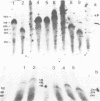Abstract
A long-range restriction map of the pseudo-autosomal or exchange pairing region (corresponding to the terminal parts of the short arms of the human sex chromosomes) has been established using pulsed field gel electrophoresis. A total of seven loci have been located on this physical map based essentially on the analysis of 45,X Turner genomes. The region spans a total of 2600 kb. The 5' end of the MIC2 gene maps at less than 80 kb from the proximal pseudo-autosomal boundary. Since the total pseudo-autosomal linkage interval represents approximately 50% of recombination at male meiosis, 1 cM corresponds to 50-60 kb. This is consistent with the almost 20-fold increase in recombination frequency observed in male versus female meiosis in this region. The present data show no distortion between both physical and linkage maps. The distribution of the CpG-rich restriction sites is notably disequilibrated. A large subset of these sites is concentrated within the 500 kb closest to the telomere whereas others appear in clusters (probably HTF islands) scattered in the rest of the pseudo-autosomal region.
Full text
PDF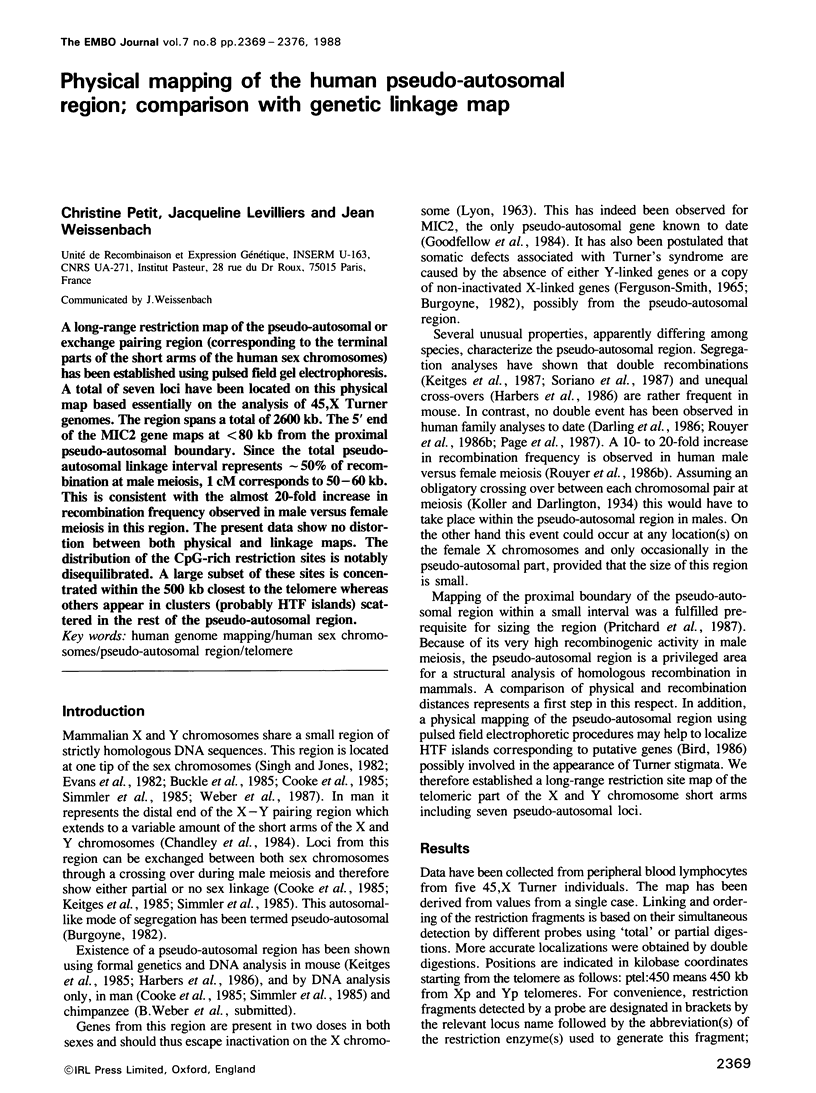

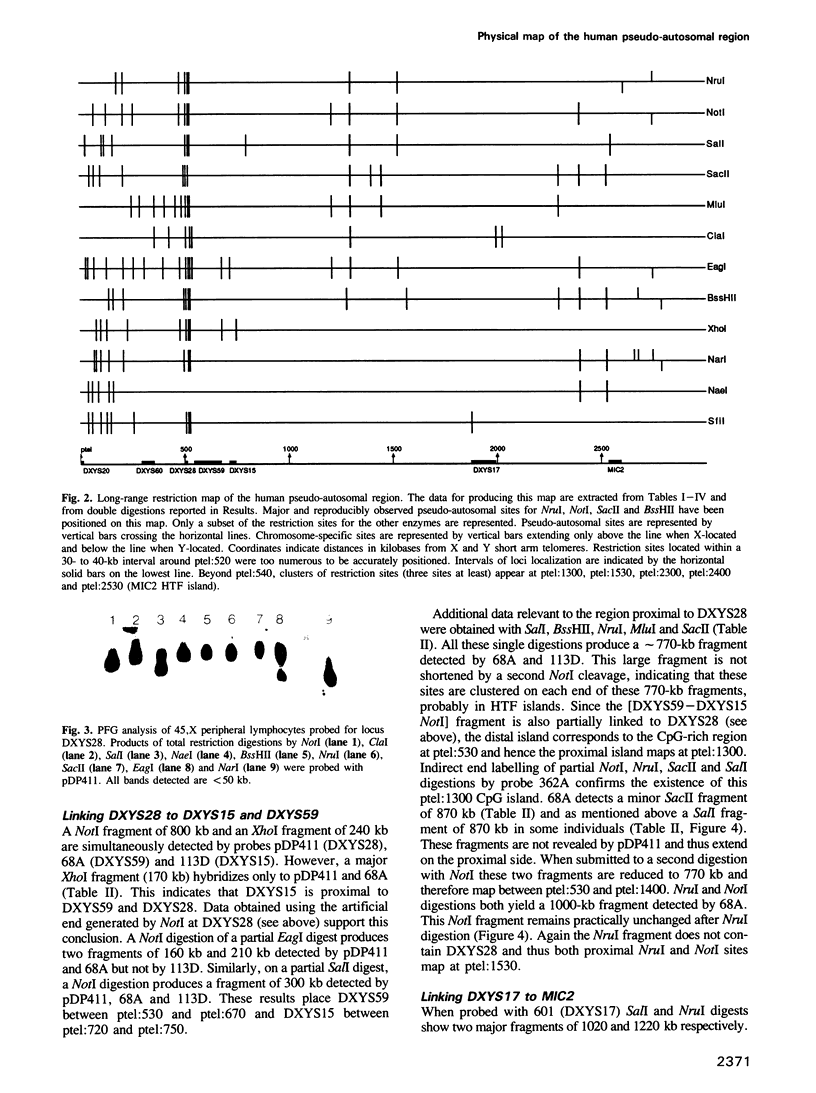
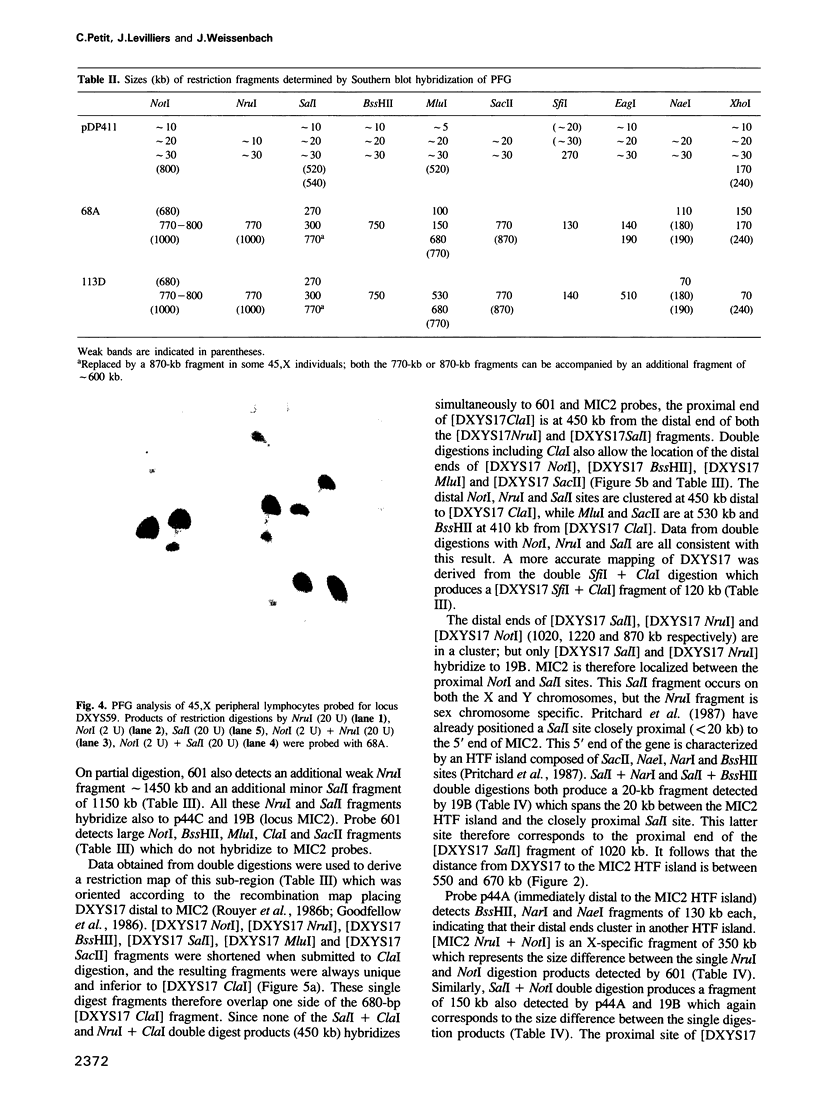
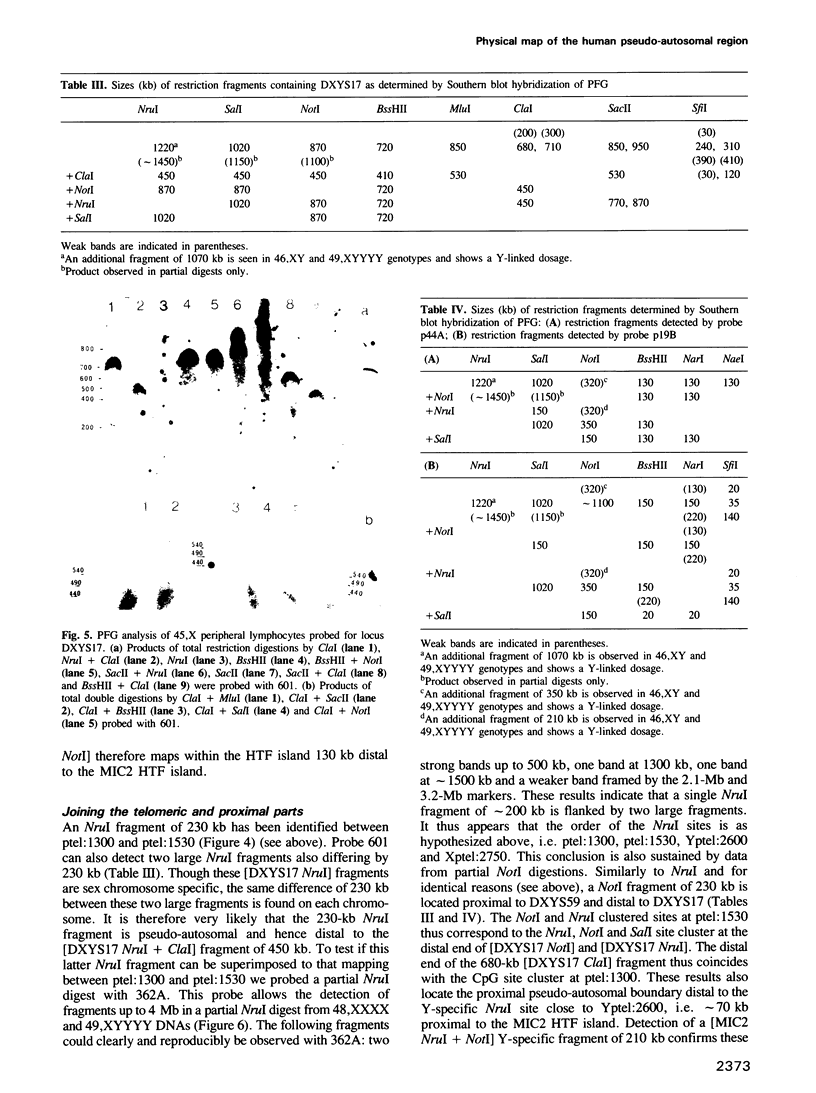
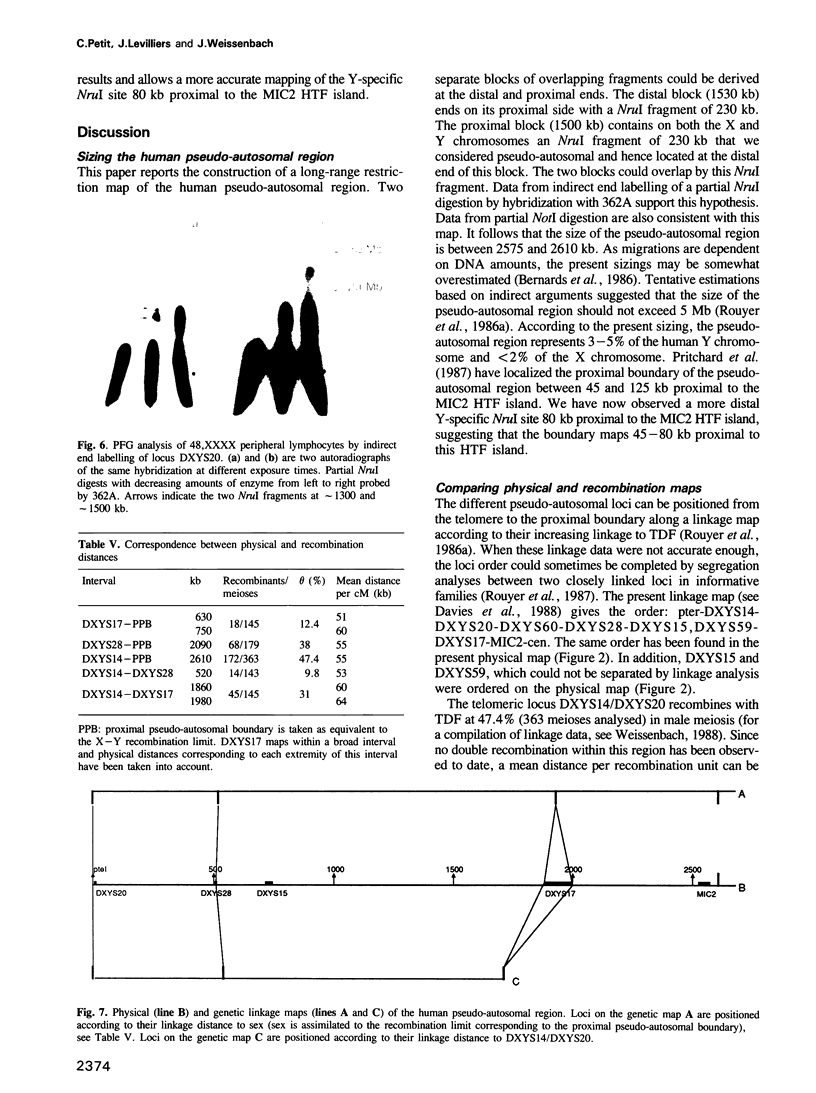
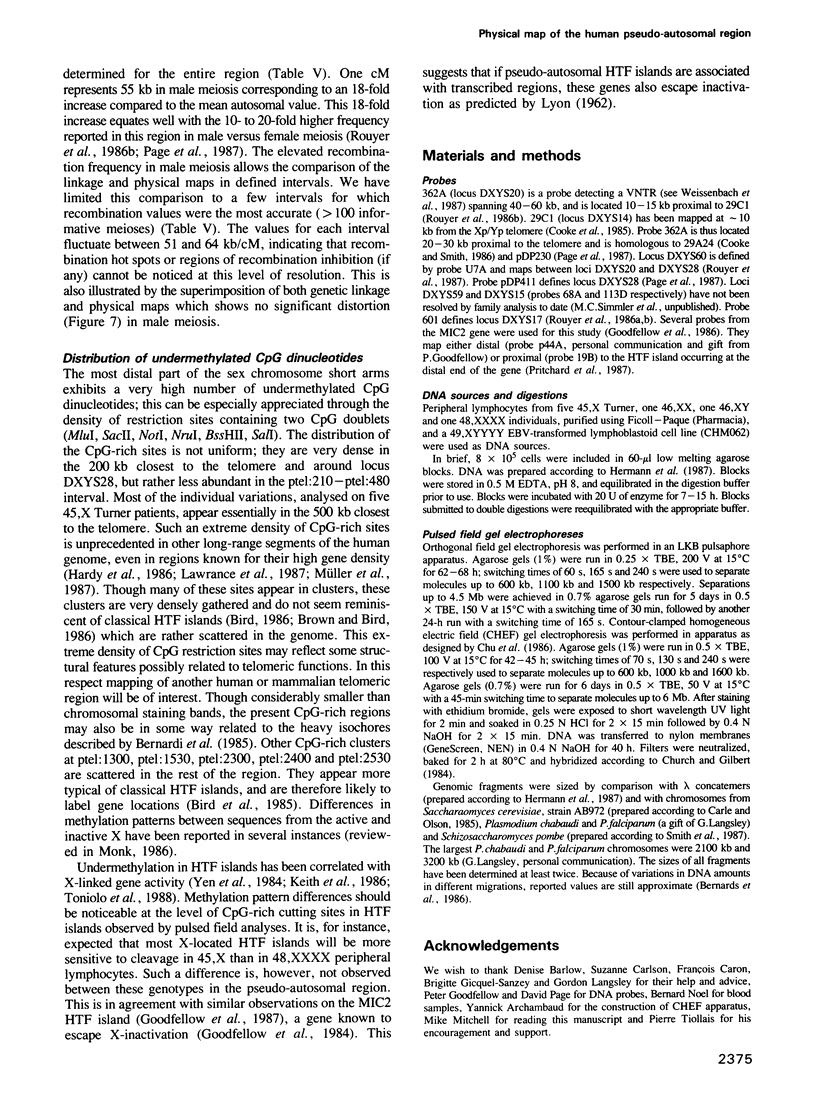

Images in this article
Selected References
These references are in PubMed. This may not be the complete list of references from this article.
- Arnold M. B. The Relation of Housing to the Isolation of Scarlet Fever and to Return Cases. Proc R Soc Med. 1912;5(SECT):150–170. [PMC free article] [PubMed] [Google Scholar]
- Bernardi G., Olofsson B., Filipski J., Zerial M., Salinas J., Cuny G., Meunier-Rotival M., Rodier F. The mosaic genome of warm-blooded vertebrates. Science. 1985 May 24;228(4702):953–958. doi: 10.1126/science.4001930. [DOI] [PubMed] [Google Scholar]
- Bernards A., Kooter J. M., Michels P. A., Moberts R. M., Borst P. Pulsed field gradient electrophoresis of DNA digested in agarose allows the sizing of the large duplication unit of a surface antigen gene in trypanosomes. Gene. 1986;42(3):313–322. doi: 10.1016/0378-1119(86)90235-0. [DOI] [PubMed] [Google Scholar]
- Bird A. P. CpG-rich islands and the function of DNA methylation. Nature. 1986 May 15;321(6067):209–213. doi: 10.1038/321209a0. [DOI] [PubMed] [Google Scholar]
- Bird A., Taggart M., Frommer M., Miller O. J., Macleod D. A fraction of the mouse genome that is derived from islands of nonmethylated, CpG-rich DNA. Cell. 1985 Jan;40(1):91–99. doi: 10.1016/0092-8674(85)90312-5. [DOI] [PubMed] [Google Scholar]
- Brown W. R., Bird A. P. Long-range restriction site mapping of mammalian genomic DNA. 1986 Jul 31-Aug 6Nature. 322(6078):477–481. doi: 10.1038/322477a0. [DOI] [PubMed] [Google Scholar]
- Buckle V., Mondello C., Darling S., Craig I. W., Goodfellow P. N. Homologous expressed genes in the human sex chromosome pairing region. Nature. 1985 Oct 24;317(6039):739–741. doi: 10.1038/317739a0. [DOI] [PubMed] [Google Scholar]
- Burgoyne P. S. Genetic homology and crossing over in the X and Y chromosomes of Mammals. Hum Genet. 1982;61(2):85–90. doi: 10.1007/BF00274192. [DOI] [PubMed] [Google Scholar]
- Carle G. F., Olson M. V. An electrophoretic karyotype for yeast. Proc Natl Acad Sci U S A. 1985 Jun;82(11):3756–3760. doi: 10.1073/pnas.82.11.3756. [DOI] [PMC free article] [PubMed] [Google Scholar]
- Chandley A. C., Goetz P., Hargreave T. B., Joseph A. M., Speed R. M. On the nature and extent of XY pairing at meiotic prophase in man. Cytogenet Cell Genet. 1984;38(4):241–247. doi: 10.1159/000132070. [DOI] [PubMed] [Google Scholar]
- Chu G., Vollrath D., Davis R. W. Separation of large DNA molecules by contour-clamped homogeneous electric fields. Science. 1986 Dec 19;234(4783):1582–1585. doi: 10.1126/science.3538420. [DOI] [PubMed] [Google Scholar]
- Church G. M., Gilbert W. Genomic sequencing. Proc Natl Acad Sci U S A. 1984 Apr;81(7):1991–1995. doi: 10.1073/pnas.81.7.1991. [DOI] [PMC free article] [PubMed] [Google Scholar]
- Cooke H. J., Brown W. R., Rappold G. A. Hypervariable telomeric sequences from the human sex chromosomes are pseudoautosomal. Nature. 1985 Oct 24;317(6039):687–692. doi: 10.1038/317687a0. [DOI] [PubMed] [Google Scholar]
- Cooke H. J., Smith B. A. Variability at the telomeres of the human X/Y pseudoautosomal region. Cold Spring Harb Symp Quant Biol. 1986;51(Pt 1):213–219. doi: 10.1101/sqb.1986.051.01.026. [DOI] [PubMed] [Google Scholar]
- Darling S. M., Goodfellow P. J., Pym B., Banting G. S., Pritchard C., Goodfellow P. N. Molecular genetics of MIC2: a gene shared by the human X and Y chromosomes. Cold Spring Harb Symp Quant Biol. 1986;51(Pt 1):205–212. doi: 10.1101/sqb.1986.051.01.025. [DOI] [PubMed] [Google Scholar]
- Evans E. P., Burtenshaw M. D., Cattanach B. M. Meitoic crossing-over between the X and Y chromosomes of male mice carrying the sex-reversing (Sxr) factor. Nature. 1982 Dec 2;300(5891):443–445. doi: 10.1038/300443a0. [DOI] [PubMed] [Google Scholar]
- FERGUSON-SMITH M. A. KARYOTYPE-PHENOTYPE CORRELATIONS IN GONADAL DYSGENESIS AND THEIR BEARING ON THE PATHOGENESIS OF MALFORMATIONS. J Med Genet. 1965 Jun;2(2):142–155. doi: 10.1136/jmg.2.2.142. [DOI] [PMC free article] [PubMed] [Google Scholar]
- Goodfellow P. J., Darling S. M., Thomas N. S., Goodfellow P. N. A pseudoautosomal gene in man. Science. 1986 Nov 7;234(4777):740–743. doi: 10.1126/science.2877492. [DOI] [PubMed] [Google Scholar]
- Goodfellow P. J., Darling S., Banting G., Pym B., Mondello C., Goodfellow P. N. Pseudoautosomal genes in man. Development. 1987;101 (Suppl):119–125. doi: 10.1242/dev.101.Supplement.119. [DOI] [PubMed] [Google Scholar]
- Goodfellow P., Pym B., Mohandas T., Shapiro L. J. The cell surface antigen locus, MIC2X, escapes X-inactivation. Am J Hum Genet. 1984 Jul;36(4):777–782. [PMC free article] [PubMed] [Google Scholar]
- Harbers K., Soriano P., Müller U., Jaenisch R. High frequency of unequal recombination in pseudoautosomal region shown by proviral insertion in transgenic mouse. Nature. 1986 Dec 18;324(6098):682–685. doi: 10.1038/324682a0. [DOI] [PubMed] [Google Scholar]
- Hardy D. A., Bell J. I., Long E. O., Lindsten T., McDevitt H. O. Mapping of the class II region of the human major histocompatibility complex by pulsed-field gel electrophoresis. Nature. 1986 Oct 2;323(6087):453–455. doi: 10.1038/323453a0. [DOI] [PubMed] [Google Scholar]
- Herrmann B. G., Barlow D. P., Lehrach H. A large inverted duplication allows homologous recombination between chromosomes heterozygous for the proximal t complex inversion. Cell. 1987 Mar 13;48(5):813–825. doi: 10.1016/0092-8674(87)90078-x. [DOI] [PubMed] [Google Scholar]
- Keitges E. A., Schorderet D. F., Gartler S. M. Linkage of the steroid sulfatase gene to the sex-reversed mutation in the mouse. Genetics. 1987 Jul;116(3):465–468. doi: 10.1093/genetics/116.3.465. [DOI] [PMC free article] [PubMed] [Google Scholar]
- Keitges E., Rivest M., Siniscalco M., Gartler S. M. X-linkage of steroid sulphatase in the mouse is evidence for a functional Y-linked allele. Nature. 1985 May 16;315(6016):226–227. doi: 10.1038/315226a0. [DOI] [PubMed] [Google Scholar]
- Keith D. H., Singer-Sam J., Riggs A. D. Active X chromosome DNA is unmethylated at eight CCGG sites clustered in a guanine-plus-cytosine-rich island at the 5' end of the gene for phosphoglycerate kinase. Mol Cell Biol. 1986 Nov;6(11):4122–4125. doi: 10.1128/mcb.6.11.4122. [DOI] [PMC free article] [PubMed] [Google Scholar]
- LYON M. F. Sex chromatin and gene action in the mammalian X-chromosome. Am J Hum Genet. 1962 Jun;14:135–148. [PMC free article] [PubMed] [Google Scholar]
- Lawrance S. K., Smith C. L., Srivastava R., Cantor C. R., Weissman S. M. Megabase-scale mapping of the HLA gene complex by pulsed field gel electrophoresis. Science. 1987 Mar 13;235(4794):1387–1390. doi: 10.1126/science.3029868. [DOI] [PubMed] [Google Scholar]
- Monk M. Methylation and the X chromosome. Bioessays. 1986 May;4(5):204–208. doi: 10.1002/bies.950040505. [DOI] [PubMed] [Google Scholar]
- Müller U., Stephan D., Philippsen P., Steinmetz M. Orientation and molecular map position of the complement genes in the mouse MHC. EMBO J. 1987 Feb;6(2):369–373. doi: 10.1002/j.1460-2075.1987.tb04764.x. [DOI] [PMC free article] [PubMed] [Google Scholar]
- Page D. C., Bieker K., Brown L. G., Hinton S., Leppert M., Lalouel J. M., Lathrop M., Nystrom-Lahti M., de la Chapelle A., White R. Linkage, physical mapping, and DNA sequence analysis of pseudoautosomal loci on the human X and Y chromosomes. Genomics. 1987 Nov;1(3):243–256. doi: 10.1016/0888-7543(87)90051-6. [DOI] [PubMed] [Google Scholar]
- Pritchard C. A., Goodfellow P. J., Goodfellow P. N. Mapping the limits of the human pseudoautosomal region and a candidate sequence for the male-determining gene. Nature. 1987 Jul 16;328(6127):273–275. doi: 10.1038/328273a0. [DOI] [PubMed] [Google Scholar]
- Rouyer F., Simmler M. C., Johnsson C., Vergnaud G., Cooke H. J., Weissenbach J. A gradient of sex linkage in the pseudoautosomal region of the human sex chromosomes. Nature. 1986 Jan 23;319(6051):291–295. doi: 10.1038/319291a0. [DOI] [PubMed] [Google Scholar]
- Rouyer F., Simmler M. C., Page D. C., Weissenbach J. A sex chromosome rearrangement in a human XX male caused by Alu-Alu recombination. Cell. 1987 Nov 6;51(3):417–425. doi: 10.1016/0092-8674(87)90637-4. [DOI] [PubMed] [Google Scholar]
- Rouyer F., Simmler M. C., Vergnaud G., Johnsson C., Levilliers J., Petit C., Weissenbach J. The pseudoautosomal region of the human sex chromosomes. Cold Spring Harb Symp Quant Biol. 1986;51(Pt 1):221–228. doi: 10.1101/sqb.1986.051.01.027. [DOI] [PubMed] [Google Scholar]
- Simmler M. C., Rouyer F., Vergnaud G., Nyström-Lahti M., Ngo K. Y., de la Chapelle A., Weissenbach J. Pseudoautosomal DNA sequences in the pairing region of the human sex chromosomes. Nature. 1985 Oct 24;317(6039):692–697. doi: 10.1038/317692a0. [DOI] [PubMed] [Google Scholar]
- Singh L., Jones K. W. Sex reversal in the mouse (Mus musculus) is caused by a recurrent nonreciprocal crossover involving the x and an aberrant y chromosome. Cell. 1982 Feb;28(2):205–216. doi: 10.1016/0092-8674(82)90338-5. [DOI] [PubMed] [Google Scholar]
- Smith C. L., Matsumoto T., Niwa O., Klco S., Fan J. B., Yanagida M., Cantor C. R. An electrophoretic karyotype for Schizosaccharomyces pombe by pulsed field gel electrophoresis. Nucleic Acids Res. 1987 Jun 11;15(11):4481–4489. doi: 10.1093/nar/15.11.4481. [DOI] [PMC free article] [PubMed] [Google Scholar]
- Soriano P., Keitges E. A., Schorderet D. F., Harbers K., Gartler S. M., Jaenisch R. High rate of recombination and double crossovers in the mouse pseudoautosomal region during male meiosis. Proc Natl Acad Sci U S A. 1987 Oct;84(20):7218–7220. doi: 10.1073/pnas.84.20.7218. [DOI] [PMC free article] [PubMed] [Google Scholar]
- Toniolo D., Martini G., Migeon B. R., Dono R. Expression of the G6PD locus on the human X chromosome is associated with demethylation of three CpG islands within 100 kb of DNA. EMBO J. 1988 Feb;7(2):401–406. doi: 10.1002/j.1460-2075.1988.tb02827.x. [DOI] [PMC free article] [PubMed] [Google Scholar]
- Weber B., Weissenbach J., Schempp W. Conservation of human-derived pseudoautosomal sequences on the sex chromosomes of the great apes. Cytogenet Cell Genet. 1987;45(1):26–29. doi: 10.1159/000132420. [DOI] [PubMed] [Google Scholar]
- Weissenbach J., Levilliers J., Petit C., Rouyer F., Simmler M. C. Normal and abnormal interchanges between the human X and Y chromosomes. Development. 1987;101 (Suppl):67–74. [PubMed] [Google Scholar]
- Yen P. H., Patel P., Chinault A. C., Mohandas T., Shapiro L. J. Differential methylation of hypoxanthine phosphoribosyltransferase genes on active and inactive human X chromosomes. Proc Natl Acad Sci U S A. 1984 Mar;81(6):1759–1763. doi: 10.1073/pnas.81.6.1759. [DOI] [PMC free article] [PubMed] [Google Scholar]






